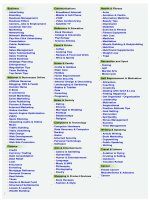Money and Banking: Lecture 44
Bạn đang xem bản rút gọn của tài liệu. Xem và tải ngay bản đầy đủ của tài liệu tại đây (579.64 KB, 29 trang )
Money and
Banking
Lecture 44
Review of the Previous Lecture
• Aggregate Supply Curve
• Short-run Aggregate Supply Curve
• Shifts in Short-run Aggregate Supply Curve
The Long-Run Aggregate
Supply Curve
• In the long run the economy moves to the
point where current output equals potential
output, while inflation is determined by
money growth
• The long-run aggregate supply curve is
vertical at the point where current output
equals potential output.
•
•
Changes in expected inflation operate
like cost shocks, shifting the short-run
aggregate supply curve up and down.
For the economy to remain in long-run
equilibrium, then, in addition to current
output equaling potential output, current
inflation must equal expected inflation
•
•
•
At any point along the long-run aggregate
supply curve, current output equals potential
output and current inflation equals expected
inflation
Potential output is constantly rising as a result
of investment and technological improvements
(the sources of economic growth), which
increase the normal output level.
Changes in the economy’s productive capacity
will shift the long-run aggregate supply curve;
increases will shift it right and decreases will
shift it left.
Equilibrium and the Determination
of Output and Inflation
A. Short-Run Equilibrium
•
Short-run equilibrium is determined by the
intersection of the aggregate demand curve
with the short-run aggregate supply curve.
Equilibrium and the Determination of Output
and Inflation
B. Adjustment to Long-Run Equilibrium
•
When current output exceeds potential, the
resulting expansionary gap exerts upward
pressure on inflation, shifting the short-run
aggregate supply curve upward, a process
that continues until output returns to
potential; at this point inflation stops
changing
Equilibrium and the Determination of Output
and Inflation
• If current output is lower than potential output,
the resulting recessionary gap places
downward pressure on inflation, causing the
short-run aggregate supply curve to shift
downward, and once again the process
continues until current output returns to
potential
Equilibrium and the Determination of Output
and Inflation
• This shows that the economy does indeed
have a self-correcting mechanism and that
the manner in which the short-run
aggregate supply curve shifts in response
to output gaps reinforces our conclusion
that the long-run aggregate supply curve
is vertical
• In long-run equilibrium, current output
equals potential output and current
inflation is steady and equal to target
inflation, which equals expected inflation
The Impact of Shifts in Aggregate
Demand on Output and Inflation
•
Suppose aggregate demand shifted right
as a result of an increase in government
purchases.
•
•
At first, current output rises but inflation does
not change.
But the higher level of output creates an
expansionary gap and the short-run
aggregate supply curve starts to shift
upward and inflation rises
The Impact of a Shift in Aggregate
Demand on Output and Inflation
Short-Run Equilibrium Inflation and Output
Following an Increase in Aggregate Demand
The Impact of a Shift in Aggregate
Demand on Output and Inflation
• 1. Start at Long-Run Equilibrium
•
•
Y = Potential Output
= Target Inflation
• 2. Aggregate Demand Shifts Right
•
•
•
Original AD shifts to New AD
Y > Potential Output
Inflation Is Unchanged
Short-run equilibrium moves from point
1 to point 2
•
•
Higher inflation moves policymakers along
their reaction curve, leading them to raise the
real interest rate and moving the economy
upward along the new aggregate demand
curve. Output then begins to fall back toward
its long-run equilibrium level.
The economy will settle at the point at which
the new aggregate demand curve crosses the
long-run aggregate supply curve and current
output again equals potential output
The Impact of a Shift in Aggregate
Demand on Output and Inflation
Adjustment of Short-Run Equilibrium Inflation and Output
Following an Increase in Aggregate Demand
The Impact of a Shift in Aggregate
Demand on Output and Inflation
• Adjustment:
• 1. At the Short-Run Equilibrium point 2:
•
Y > Potential Output
• 2. SRAS begins to shift up
•
•
Output begins to fall
Inflation begins to rise as economy moves along
New AD
• 3. With no policy response, economy moves
to point 3, where
• Current inflation >Target inflation
The Impact of a Shift in Aggregate
Demand on Output and Inflation
• If central bankers simply sit and watch as
the aggregate demand curve shifts to the
right, inflation will rise
• So long as monetary policymakers remain
committed to their original inflation target,
they will need to do something to get the
economy back to the point where it began
—point “1”
The Impact of a Shift in Aggregate
Demand on Output and Inflation
• An increase in government purchases
raises the long‑term real interest rate.
• Policymakers will compensate by shifting
their monetary policy reaction curve to the
left, increasing the real interest rate at
every level of inflation
The Impact of a Shift in Aggregate
Demand on Output and Inflation
• When the monetary policy reaction curve
shifts, the aggregate demand curve shifts
with it.
• The aggregate demand curve will shift to
the left, bringing the economy back to
long-run equilibrium.
The Impact of a Shift in Aggregate
Demand on Output and Inflation
• An increase in aggregate demand causes
a temporary increase in both output and
inflation.
• A decline in aggregate demand causes a
temporary decline in both output and
inflation
The Impact of a Shift in Aggregate
Demand on Output and Inflation
• This discussion implies that whenever we
see a permanent increase in inflation, it
must be the result of monetary policy.
• That is, if inflation goes up or down and
remains at its new level, the only
explanation is that central bankers must
be allowing it to happen.
• They have changed their inflation target,
whether or not they acknowledge the
change explicitly.
The Impact of Inflation Shocks on Output
and Inflation
•
•
An inflation shock shifts the short-run
aggregate supply curve (such as an oil
price increase )
A positive shock moves it to a higher
level, and the result is higher inflation
and lower output, a situation called
“stagflation”.









